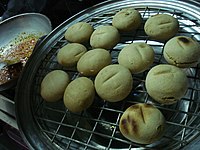Sattu
Sattu is a type of flour, mainly used in Nepal, India, Bangladesh and Pakistan. It consists of a mixture of ground pulses and cereals. The dry powder is prepared in various ways as a principal or secondary ingredient of dishes.
Sattu is an essential part of vegetarian cuisine as it can be an important source of protein. Sattu is being recognised as a superfood now by lifestyle and wellness gurus.
History[]
The process of preparing sattu is ancient[1] and is popular over a wide area of North India, particularly Bihar and Uttar Pradesh.

Uses[]

Sattu is used in regional cuisine to varying degrees. In Bihar, Uttar Pradesh, Uttrakhand, Punjab and Delhi the use of sattu is extensive in various dishes. In Bihar, it is commonly served cold as a savory drink during intense heat waves in summer or as a porridge or soft dough. Sweet dishes combine sattu with fruit slices, sugar and milk. In savoury dishes, sattu may be flavored with green chili, lemon juice and salt. It is a popular stuffing in parathas. In Bihar, sattu is prepared with toasted gram flour as well as toasted barley, or a mixture of both. Sattu mixed with a little mustard oil and some spices is used as a stuffing in the traditional Bihari food litti.
In Punjab, it is used as a cold drink to mitigate heat and dehydration effects. The traditional way is to mix it with water and shakker (Hindi) (jaggery). Here sattu is a mix of toasted, ground barley, while some variants are also prepared by grinding roasted grams.
In Odisha, it is a popular breakfast and also called chhatua. Though there are many different ways to prepare chhatua, also known as sattu. It is generally mixed with ripe bananas, cottage cheese (chenna), yogurt or milk.
Sattu made from ground barley can also be mixed with salt and turmeric and rolled into balls. Alternatively, millet and corn grains are also used.[1]
Sattu is believed[citation needed] to be a great source of protein and many other minerals.
Ingredients[]
Sattu is prepared by dry roasting grains or grams, most often barley or bengal gram. In Odisha, Sattu or Chatua is made by dry roasting cashew, almond, millet, barley and chickpea and grinding to a fine flour. The traditional way of preparing sattu involves the use of an iron vessel in which the grains or grams are roasted in sand. Afterwards they are sieved and then ground into a fine flour.
Geography[]
Sattu is popular in the states of Uttar Pradesh, Bihar, Madhya Pradesh,[2] Jharkhand, Dhulikhel (Nepal), Rajasthan and the Punjab region.[1]
References[]
- ^ Jump up to: a b c Harkesh Singh Kehal. Alop Ho Riha Punjabi Virsa. Pub. Lokgeet Parkashan. ISBN 81-7142-869-X
- ^ Kumar Suresh Singh, Anthropological Survey of India (2008). People of India, Volume 16, Part 1. p. xxix. "However this term of opprobrium ignores the fact that the sattu is nutritious and has sustained the Bihari..."
External links[]
- Indian cuisine
- Bihari cuisine
- Odia cuisine
- Jharkhandi cuisine